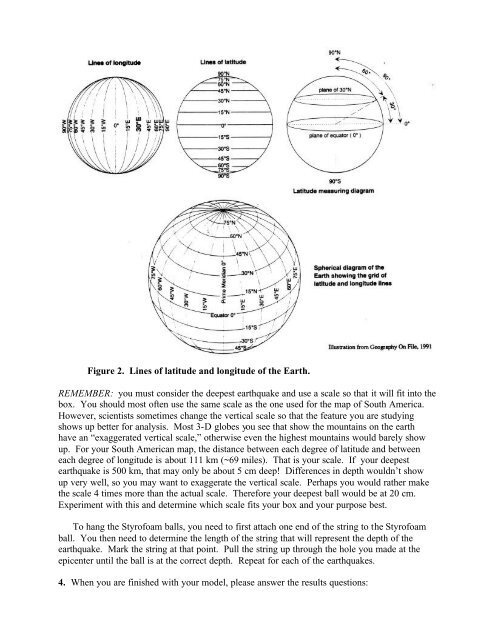Real Evidence of a Subducting Plate - Geological Society of America
Real Evidence of a Subducting Plate - Geological Society of America
Real Evidence of a Subducting Plate - Geological Society of America
You also want an ePaper? Increase the reach of your titles
YUMPU automatically turns print PDFs into web optimized ePapers that Google loves.
Figure 2. Lines <strong>of</strong> latitude and longitude <strong>of</strong> the Earth.<br />
REMEMBER: you must consider the deepest earthquake and use a scale so that it will fit into the<br />
box. You should most <strong>of</strong>ten use the same scale as the one used for the map <strong>of</strong> South <strong>America</strong>.<br />
However, scientists sometimes change the vertical scale so that the feature you are studying<br />
shows up better for analysis. Most 3-D globes you see that show the mountains on the earth<br />
have an “exaggerated vertical scale,” otherwise even the highest mountains would barely show<br />
up. For your South <strong>America</strong>n map, the distance between each degree <strong>of</strong> latitude and between<br />
each degree <strong>of</strong> longitude is about 111 km (~69 miles). That is your scale. If your deepest<br />
earthquake is 500 km, that may only be about 5 cm deep! Differences in depth wouldn’t show<br />
up very well, so you may want to exaggerate the vertical scale. Perhaps you would rather make<br />
the scale 4 times more than the actual scale. Therefore your deepest ball would be at 20 cm.<br />
Experiment with this and determine which scale fits your box and your purpose best.<br />
To hang the Styr<strong>of</strong>oam balls, you need to first attach one end <strong>of</strong> the string to the Styr<strong>of</strong>oam<br />
ball. You then need to determine the length <strong>of</strong> the string that will represent the depth <strong>of</strong> the<br />
earthquake. Mark the string at that point. Pull the string up through the hole you made at the<br />
epicenter until the ball is at the correct depth. Repeat for each <strong>of</strong> the earthquakes.<br />
4. When you are finished with your model, please answer the results questions:
















